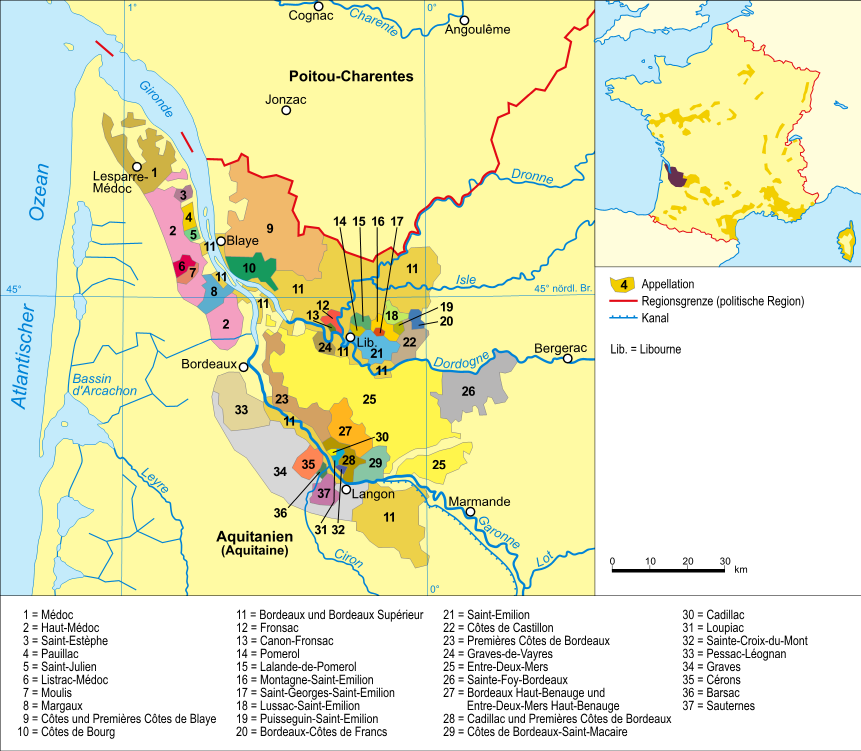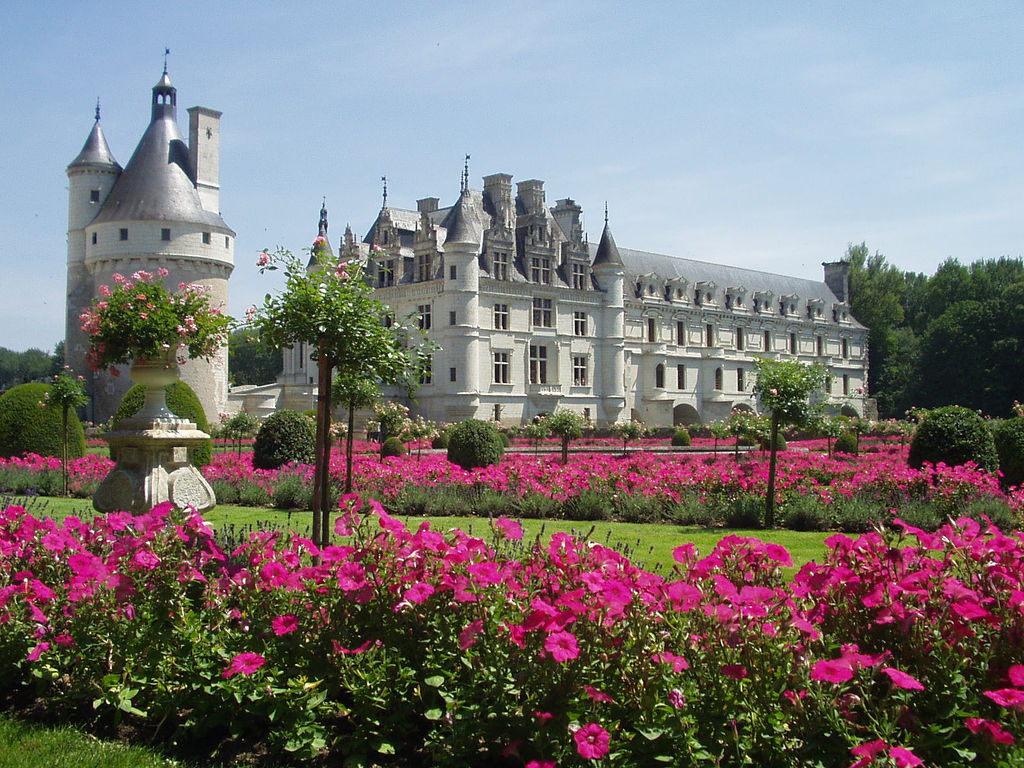|
Château Canon (Saint-Émilion)
Château Canon, originally Clos St-Martin, is a Bordeaux wine from the Saint-Émilion AOC, Saint-Émilion Appellation d'origine contrôlée, appellation, ranked among the Premiers grands crus classés B in the Classification of Saint-Émilion wine. The winery is located just southwest of the old town of Saint-Émilion within the commune of the same name, closely neighbouring the estates such as Château Magdelaine, Château La Gaffelière and Château Ausone and has since the early 20th century been considered one of the top Saint-Émilions. History Originally a small vineyard planted around the Church of St-Martin by Jean Biès in the early 18th Century, the estate was named Clos St-Martin, sold in 1760 to Jacques Kanon, probably the source of the name Canon. A true ''clos'', the original 12 hectare vineyard was encircled by a wall, which Kanon expanded by acquiring seven small surrounding vineyards. He sold it on in 1770 with great profit to Raymond Fontémoing, a leading Libour ... [...More Info...] [...Related Items...] OR: [Wikipedia] [Google] [Baidu] |
Bordeaux Wine
Bordeaux wine (; ) is produced in the Bordeaux region of southwest France, around the city of Bordeaux, on the Garonne River. To the north of the city, the Dordogne River joins the Garonne forming the broad estuary called the Gironde; the Gironde department, with a total vineyard area of 110,800 hectares, is the second largest wine-growing area in France behind the Languedoc-Rousillon. Average vintages produce over 700 million bottles of wine, ranging from large quantities of daily table wine to some of the world's most expensive and prestigious wines. The vast majority of wine produced in Bordeaux is red (sometimes called "claret" in Britain), with sweet white wines (most notably Sauternes), dry whites, and (in much smaller quantities) rosé and sparkling wines ( Crémant de Bordeaux) collectively making up the remainder. Bordeaux wine is made by more than 5,660 producers or ''châteaux''. There are 65 appellations of Bordeaux wine. History Viticulture was introduce ... [...More Info...] [...Related Items...] OR: [Wikipedia] [Google] [Baidu] |
Saint-Émilion AOC
Saint-Émilion () is an ''appellation d'origine contrôlée'' (AOC) for red wine in the Bordeaux wine region of France, where it is situated in the Libourne subregion on the right bank of the Dordogne (river), Dordogne. As a cultural landscape demonstrating a long, living history of wine-making (dating from Roman times), Saint-Émilion was registered as a UNESCO World Heritage Site in 1999. Its represent 67.5% of the total area of wine-producing communes (Saint-Émilion, Saint-Christophe-des-Bardes, Saint-Hippolyte, Gironde, Saint-Hippolyte, Saint-Étienne-de-Lisse, Saint-Laurent-des-Combes, Gironde, Saint-Laurent-des-Combes, Saint-Pey-d'Armens, Saint-Pey-d’Armens, Saint-Sulpice-de-Faleyrens, Vignonet, and a part of the Libourne commune) and 6% of the total Bordeaux vineyard. The wines of Saint-Émilion are typically blended from different grape varieties, the three main ones being Merlot, Cabernet Franc and Cabernet Sauvignon. Classification Since 1955, there has been ... [...More Info...] [...Related Items...] OR: [Wikipedia] [Google] [Baidu] |
Appellation D'origine Contrôlée
In France, the ''appellation d'origine contrôlée'' (, ; abbr. AOC ) is a label that identifies an agricultural product whose stages of production and processing are carried out in a defined geographical area – the ''terroir'' – and using recognized and traditional know-how. The specificity of an AOC product is determined by the combination of a physical and biological environment with established production techniques transmitted within a human community. Together, these give the product its distinctive qualities. The defining technical and geographic factors are set forth in standards for each product, including wines, cheeses and meats. Other countries and the European Union have similar labeling systems. The European Union's protected designation of origin (PDO and PGI) system has harmonized the protection of all geographical indications and their registration. When labelling wine however, producers may still use recognized traditional terms like AOC, and are not requ ... [...More Info...] [...Related Items...] OR: [Wikipedia] [Google] [Baidu] |
Classification Of Saint-Émilion Wine
In 1955, the Saint-Émilion AOC, wines of Saint-Émilion in the wine-growing region of Bordeaux wine, Bordeaux were classified. Unlike the Bordeaux Wine Official Classification of 1855 covering wines from the Médoc and Graves (wine region), Graves regions, the Saint-Émilion list is updated every 10 years or so. Following the initial classification, the list was updated in 1969, 1986, 1996, 2006, 2012, and 2022. However the 2006 classification was declared invalid following a series of legal actions, and the 1996 version of the classification has been reinstated for the vintages from 2006 to 2009. The region's ''Syndicat Viticole'' started planning for a classification of St.-Émilion wine in 1930, but it was not until October 7, 1954, that the principles behind the classification became official when the Institut National des Appellations d'Origine, INAO agreed to take responsibility for handling the classification. The first list of classified St.-Émilion estates was published ... [...More Info...] [...Related Items...] OR: [Wikipedia] [Google] [Baidu] |
Winery
A winery is a building or property that produces wine, or a business involved in the cultivation and production of wine, such as a wine company. Some wine companies own many wineries. Besides wine making equipment, larger wineries may also feature warehouses, bottling lines, laboratories, and large expanses of tanks known as tank farms. Wineries may have existed as long as 8,000 years ago. Ancient history The earliest known evidence of winemaking at a relatively large scale, if not evidence of actual wineries, has been found in the Middle East. In 2011 a team of archaeologists discovered a 6000 year old wine press in a cave in the Areni region of Armenia, and identified the site as a small winery. Previously, in the northern Zagros Mountains in Iran, jars over 7000 years old were discovered to contain tartaric acid crystals (a chemical marker of wine), providing evidence of winemaking in that region. Archaeological excavations in the southern Georgian region of Kvemo Kartli ... [...More Info...] [...Related Items...] OR: [Wikipedia] [Google] [Baidu] |
Château Magdelaine
A château (, ; plural: châteaux) is a manor house, or palace, or residence of the lord of the manor, or a fine country house of nobility or gentry, with or without fortifications, originally, and still most frequently, in French-speaking regions. Nowadays, a ''château'' may be any stately residence built in a French style; the term is additionally often used for a winegrower's estate, especially in the Bordeaux region of France. Definition The word château is a French word that has entered the English language, where its meaning is more specific than it is in French. The French word ''château'' denotes buildings as diverse as a medieval fortress, a Renaissance palace and a fine 19th-century country house. Care should therefore be taken when translating the French word ''château'' into English, noting the nature of the building in question. Most French châteaux are "palaces" or fine "country houses" rather than "castles", and for these, the word "château" is appropria ... [...More Info...] [...Related Items...] OR: [Wikipedia] [Google] [Baidu] |
Château La Gaffelière
Château La Gaffelière, previously Château Gaffelière-Naudes, is a Bordeaux wine from the Saint-Émilion appellation, ranked among the Premiers grands crus classés B in the Classification of Saint-Émilion wine. The winery is located west of Château Pavie, just south of the town of Saint-Émilion, within the commune of the same name. The château also produces a second wine named Clos La Gaffelière. History Founded on the ruins of a Gallo-Roman villa named "Le Palat", and later a 17th-century leper colony, the estate was sharecropping land that came to the ownership of the Comte de Malet-Roquefort. The word "gaffet" translates to leper. Near the end of the 19th century, the original extensive estate was divided into what became Château Canon-la-Gaffelière, and the area then called Puygenestous-Naudes, renamed Château Gaffelière-Naudes. The name was simplified after 1963. After three centuries, it still belongs to the Malet-Roquefort family. Production From 25 hectares t ... [...More Info...] [...Related Items...] OR: [Wikipedia] [Google] [Baidu] |
Château Ausone
Château Ausone is a Bordeaux wine from Saint-Émilion appellation, previously ranked Premier Grand Cru Classé (A) in the Classification of Saint-Émilion wine but does not hold this rank after the 2022 reclassification. The winery is located on the Right Bank of France's Bordeaux wine region in the Gironde department, close to the town of Saint-Émilion. The winery also produces a second wine named Chapelle d'Ausone. History Placed on the western edge of 11th century village Saint-Émilion, with elevated vineyards facing south on steep terraces in ideal situation, Ausone takes its name from Decimius Magnus Ausonius (310–395 AD), a statesman and poet from Bordeaux who owned about of vineyard. It is believed by some that Château Ausone is on the foundations of his villa. The modern estate can be dated to the 18th century, when it was owned by Jean Cantenat. Later, under the ownership of the Lafargue family, the vineyard was inherited by Edouard Dubois who steered the châ ... [...More Info...] [...Related Items...] OR: [Wikipedia] [Google] [Baidu] |
Château Canon, 1er Grand Cru Classé
A château (, ; plural: châteaux) is a manor house, or palace, or residence of the lord of the manor, or a fine country house of nobility or gentry, with or without fortifications, originally, and still most frequently, in French-speaking regions. Nowadays, a ''château'' may be any stately residence built in a French style; the term is additionally often used for a winegrower's estate, especially in the Bordeaux wine regions, Bordeaux region of France. Definition The word château is a French word that has entered the English language, where its meaning is more specific than it is in French. The French word ''château'' denotes buildings as diverse as a medieval fortress, a Renaissance palace and a fine 19th-century country house. Care should therefore be taken when translating the French word ''château'' into English, noting the nature of the building in question. Most French châteaux are "palaces" or fine "English country house, country houses" rather than "castles", an ... [...More Info...] [...Related Items...] OR: [Wikipedia] [Google] [Baidu] |





